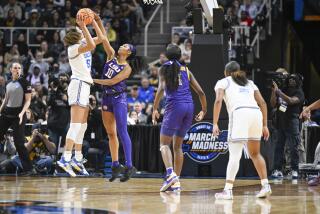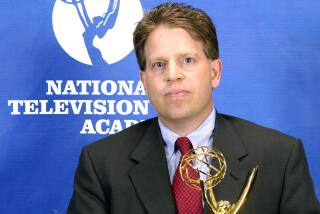Book review: ‘ESPN: Those Guys Have All the Fun’
Minus the self-congratulation and TV industry dialectics — the vividly recalled meetings, the anecdotes in which the on-air talent receives recognition/reaches pinnacle of career/wins a Sports Emmy — there’s some pretty good stuff in the new book on the history of ESPN, called, “Those Guys Have All the Fun.”
The title is meant to convey the party school atmosphere at the all-sports network, if not serve as some ironic comment on life in Bristol, Conn., where ESPN has been headquartered since it was launched in 1979, and which, as many an ESPN employee makes clear in this book, is an Area 51 of culture.
Longtime fans of “SportsCenter” or “NFL Primetime” looking for insider dirt can rest easy; though “Those Guys Have All the Fun” clocks in at 745 pages, you can skim the work and odds are something like 3-1 that you’ll hit a suspension or other form of turbulence.
The back-biting ranges from the predictable (longtime anchor Bob Ley on bad-boy Keith Olbermann’s departure from ESPN in 1997: “We felt not so much relief when Keith left as unrestrained [expletive] joy”) to the wickedly droll (John Walsh, variously credited as the man who created “SportsCenter’s” enduring panache, on former anchor Craig Kilborn: “…Craig Kilborn came in and demanded twice the salary because [‘SportsCenter’] was going to be twice as long. He’s now in L.A. somewhere.”)
My favorite sentence in the book is: “What I said about Hitler was taken out of context.” This comes from analyst and former coach Lou Holtz, explaining why he used der Führer to dissect Michigan football.
This sort of over-heated verbiage is now the lingua franca of our national discussion about sports, and it’s principally what bogs down “Those Guys Have All the Fun,” from James Andrew Miller and longtime Washington Post TV critic Tom Shales.
As they did in their previous book, “Live From New York: An Uncensored History of ‘Saturday Night Live,”’ Miller and Shales provide interstitial narration to transition the many eyewitness accounts and anecdotes.
“The Worldwide Leader in Sports,” as ESPN has long promoted itself, is today a more forceful cultural institution than “Saturday Night Live,” if also a less interesting fishbowl. By definition, an eyewitness oral history of ESPN leaves us at the narrative mercy of people who are nothing if not highly evolved in the practice of using many more words than they need to in order to say the somewhat un-surprising thing that they are trying to say.
Here, for instance, is “Monday Night Football” play-by-play man Mike Tirico talking about his chemistry issues with ex-sidekick Tony Kornheiser: “Tony had done some radio hosting and things like that, so Tony’s skill set for what he could bring to the game, the vision of what he was going to bring to the game, I think they felt that my pure experience would make them work and would give them the best chance to succeed. So that’s where I think I ended up as the person that they pointed to regarding that. I hope it doesn’t come off as conceited.”
No worries. Such quotes, presented unexpurgated, can veer into the ad absurdum. Sometimes, though, the sinkhole of verbiage lifts and a key episode in the network’s history takes page-turning shape. In the early 1990s, as the “Worldwide Leader” was launching ESPN2 and looking to become more than a sports junkie’s paradise, in came John Lack of MTV and, later, Mark Shapiro, who had cut his teeth producing firebrand Jim Rome.
Shapiro, particularly, emerges as the boy devil of Bristol. Having gone through various corporate owners, ESPN had become a Disney property by the time Shapiro was charged by then Disney-chief Michael Eisner with juicing the network’s ratings across its platforms of ESPN, ESPN2 and the retro ESPN Classic. Soon, the culture war was on backstage between floor generals Shapiro and the older John Walsh, who came from print (editor of the magazine Inside Sports) and whose role at ESPN seems to have been to exhort the sports lads to locate their journalistic integrity.
Shapiro would bring in rhetorical haymakers like Kornheiser and Rush Limbaugh and ultimately alienate Al Michaels and John Madden out of the booth when ESPN acquired “Monday Night Football.”
The acquisition of the “Monday Night Football” brand in 2005 should have been a crowning moment for ESPN. Except that the man on the other side of the bargaining table from Shapiro was his former ESPN boss, Steve Bornstein, now working for the NFL and conveniently engineering things so that NBC could swoop in and become an NFL player on Sunday nights.
Shapiro’s tenure was thematically appropriate, given that it coincided with the explosion of original shows on cable and an ever-more-obsessive chase for young, distracted viewers. By the time Shapiro left, in 2005, ESPN had a deal with the NBA, had launched poker, had launched the Spanish-language ESPN Deportes, had brought back NASCAR. The network had officially become a cacophony.
And yet, the greater legacy of the network is not its game-changing sports coverage but its business model. The story of ESPN traces the rise of cable TV as a two-headed monster, generating revenue not just by selling ad time (the traditional network TV model) but by charging cable providers carriage fees. The best characters in Shales and Miller’s book are not surly-sounding talent like Peter Gammons or Kornheiser or even the bombastic Chris Berman, they’re the father and son who somewhat unwittingly created ESPN in 1979 and the series of deep-pocketed corporate bosses and canny business executives who faced down cable operators in ESPN’s early days until they agreed to pay a fee to carry the all-sports channel.
In the book, Eisner, contradicted by others, claims that when Disney bought Capital Cities/ABC for a reported $19 billion in 1995, it was the ancillary property ESPN, and not broadcast network ABC, that the studio salivated over.
“I liked the culture in Bristol, and I liked the economic model,” is how Eisner assesses ESPN’s setup. “They were in a Days Inn mode. They were not chained by 75 years of Hollywood labor practices — not only unions, but the New York and L.A. cost of living. They weren’t on the star system because there was no star system.” Even the network’s biggest “stars” discovered this. “It all comes back to what people say about the place — they don’t care about talent. Couldn’t care less,” said Dan Patrick, when he left the network in 2007 after 18 years.
As for the other talent — the athletes flying to the hoop or crushing each other on the field—ESPN continues to get them for free, night after night, year after year. In this win-win scenario, athletes love the attention they get on ESPN, and the ESPN guys love that athletes love the attention.
Add to this the approximately 100 million homes that now get ESPN, the nice little taste of everybody’s cable bill the network receives (about $4, according to the book), and serve.
More to Read
Sign up for our Book Club newsletter
Get the latest news, events and more from the Los Angeles Times Book Club, and help us get L.A. reading and talking.
You may occasionally receive promotional content from the Los Angeles Times.






